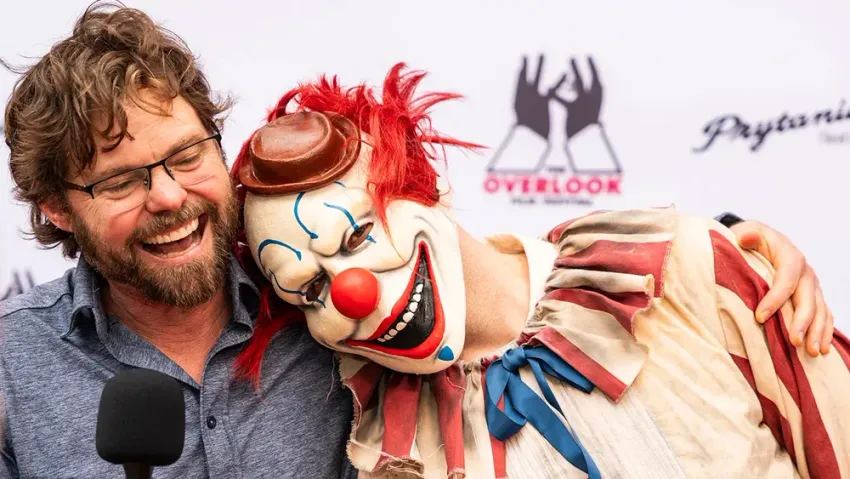I first met Clown in a Cornfield director Eli Craig when he came to town in 2010 with actor Tyler Labine to showcase his feature-length debut, Tucker & Dale vs. Evil, at the Seattle International Film Festival. Since its original release, the goofy and gory horror comedy has grown into a minor cult classic, and the director remembers his time in the Pacific Northwest with great fondness.
“I love Seattle,” said Craig. “I love the Seattle film scene. I wish we could have played [Clown in a Cornfield] at this year’s festival.”
His inventive, new genre-bending slasher yarn hit theaters a few weeks too early for that to happen, but I still got a few minutes to reunite with him over Zoom to chat about his latest opus. An adaptation of the first book in author Adam Cesare’s best-selling trilogy of young adult horror tales, the story follows teenager Quinn Maybrook (Katie Douglas) and her father Dr. Glenn Maybrook (Aaron Abrams), who have moved to the small community of Kettle Springs for a fresh start.
But when the high school senior falls in with what the local sheriff (Will Sasso) calls “the wrong crowd” — a group that includes Cole (Carson MacCormac), the son of the wealthy owner of the Baypen Corn Syrup company Arthur Hill (Kevin Durand) — things quickly turn homicidal for the shocked newcomer. Turns out, the company’s popular mascot, a cartoonish clown named Frendo, doesn’t take kindly to youngsters who stir up trouble, and it’s more than happy to dismember anyone who disrupts the conservative status quo.
“The thing that was appealing to me about the whole concept and Carter Blanchard’s [first draft] of the script, which was a total blast to read, is that there is a moment at the midpoint where everything shifts,” explained Craig. “It all becomes a different movie, with higher stakes than it’s been set up to be.
“I’m always looking for something that is a reversal of horror tropes, that is a unique take on a familiar theme. I saw this moment as something I could have a good time with and really sink my teeth into. [This moment] gives a new definition to Frendo. He is a killer clown with so many more tools at his disposal than it initially appears. He’s like this hardcore blue-collar clown. It was so much fun to have a diversity of potential kills and methods for him to utilize.”
But there is more to Clown in a Cornfield than a collection of inventive kills and humorous one-liners. Cesare’s source material is an inspired social commentary, eerily prescient in its evaluation of current events, right-wing talking points, and attempts to Stepford-ize gender roles back to the 1950s. The setting is culturally diverse, where teens of various backgrounds work to change their community for the better. The malevolent clown tries to stop them, even if that means eviscerating some of them with a chainsaw or impaling them on a pitchfork.
“That’s the other part that attracted me to the material and to the book,” said Craig. “It works on so many levels. [The story] works as a fun ride, and I’m always trying to make a roller coaster for my movies, where you fall in love with the characters and they help usher you through a harrowing experience. But with this one, also as with everything I try to do, it has so many layers to it. If you watch it a second or a third time, you’ll find all of these complex themes working inside that beg to be explored.
“I think we need to have movies that aren’t necessarily hammering a message home but are still speaking to themes happening right now in our society. It’s okay to leave things a little unsolved for audiences to figure out for themselves. It’s okay to give them something to think about.”
Part of leaving audiences with plenty to ponder afterward includes not only key character reveals for some of the teenagers but also how their friends react to these unexpected revelations, most of which are met with acceptance and support.
“It’s interesting,” mused Craig. “There are themes involving our lead and supporting characters that are an integral part of the movie without being the central theme... There are character arcs that, in a different story, would be about that: their sexual identity, all of that.
“Here, it’s really just people struggling with their identity within the movie, these teens figuring out who they are in the midst of a life-or-death situation. Things come to the surface during that situation that can make them angry or upset, but it also makes them more real.”
He added, “I think the reason why horror is in the zeitgeist right now is that it makes us feel more alive and that it can talk about current events in ways other genres cannot. You get to follow the final girl through to her potential heroic survival and feel that joy with her. Yet there’s more to it than that. More to explore, learn, and feel.”
Craig paused for a moment and flashed a crooked smile. “But I also want them to feel like they want more Frendo,” he said, stifling a laugh. “If you want more Frendo, please, go see this in a theater. There’s an entire world that Adam has created, a whole world of Kettle Springs, and so much more to play with. There are so many more stories to tell.”
Support the Seattle Gay News: Celebrate 50 Years with Us!
As the third-oldest LGBTQIA+ newspaper in the United States, the Seattle Gay News (SGN) has been a vital independent source of news and entertainment for Seattle and the Pacific Northwest since 1974.
As we celebrate our 51st year, we need your support to continue our mission.
A monthly contribution will ensure that SGN remains a beacon of truth and a virtual gathering place for community dialogue.
Help us keep printing and providing a platform for LGBTQIA+ voices.
How you can donate!
Using this Link
Text "SGN" to 53-555
Or Scan the QR code below!



